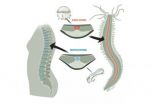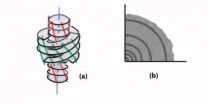(Press-News.org) A strange thing happened on the way to dealing with climate change: Advances in hydraulic fracturing put trillions of dollars' worth of previously unreachable oil and natural gas within humanity's grasp.
The environmental costs – and benefits – from "fracking," which requires blasting huge amounts of water, sand and chemicals deep into underground rock formations, are the subject of new research that synthesizes 165 academic studies and government databases. The survey covers not only greenhouse gas impacts but also fracking's influence on local air pollution, earthquakes and, especially, supplies of clean water.
The authors are seven environmental scientists who underscore the real consequences of policy decisions on people who live near the wells, as well as some important remaining questions.
"Society is certain to extract more gas and oil due to fracking," said Stanford environmental scientist Robert Jackson, who led the new study. "The key is to reduce the environmental costs as much as possible, while making the most of the environmental benefits."
Fracking's consumption of water is rising quickly at a time when much of the United States is suffering from drought, but extracting natural gas with hydraulic fracturing and horizontal drilling compares well with conventional energy sources, the study finds. Fracking requires more water than conventional gas drilling; but when natural gas is used in place of coal or nuclear fuel to generate electricity, it saves water. From mining to generation, coal power consumes more than twice the water per megawatt-hour generated than unconventional gas does.
Unconventional drilling's water demand can be better or worse than alternative energy sources, the study finds. Photovoltaic solar and wind power use almost no water and emit no greenhouse gas, but cheap, abundant natural gas may limit their deployment as new sources of electricity. On the other hand, fracked gas requires less than a hundredth the water of corn ethanol per unit of energy.
Fracking's impact on both climate change and local air pollution is similar to its impact on water, finds the study "The Environmental Costs and Benefits of Fracking," published in the Annual Review of Environment and Resources.
Getting a fractured well going is more intense than for conventional oil and gas drilling, with potential health threats arising from increases in volatile organic compounds and air toxics.
But when natural gas replaces coal as a fuel for generating electricity, the benefits to air quality include lower carbon dioxide emissions than coal and almost none of the mercury, sulfur dioxide or ash.
Globally, though, relief to climate change is uncertain, the study finds. "While the increased gas supply reduces air pollution in U.S. cities downwind from coal-fired power plants, we still don't know whether methane losses from well pads and pipelines outweigh the lower carbon dioxide emissions," said Jackson.
In the eastern United States, fears of contaminated drinking water have raised more concerns than fracking's water consumption. Gas and chemicals from manmade fractures thousands of meters underground very rarely seep upward to drinking-water aquifers, the study says. The real threats are failures in the steel and cement casings of wells nearer to the surface and the disposal of wastewater, the study finds. Numerous previous studies have shown that casings fail between 1 percent and 10 percent of the time, depending on geology and well construction.
Cases of groundwater contamination have been hotly debated, but the new study finds that the overwhelming evidence suggests it has happened, albeit not commonly. Is the methane contamination observed in drinking water a precursor to other toxins – arsenic, various salts, radioactive radium and other metals – making their way up slowly? The researchers do not yet know. A few recent studies suggest the answer could be "yes" in rare cases.
How oil and gas companies handle wastewater – fluid used to fracture the shale that flows back up the well and water unleashed with the oil and gas – shows the importance of state policies. "Wastewater disposal is one of the biggest issues associated with fracking," said co-author Avner Vengosh, a professor of geochemistry at Duke University.
Most fracking wastewater in the United States is injected deep underground, and an increasing amount is recycled for subsequent drilling or sent to advanced water treatment facilities. However, a handful of states still allow the wastewater to be used for watering cattle, sprayed onto roads for dust control or sent to municipal water-treatment plants not equipped to handle the chemicals involved.
All bad ideas, according to the authors of the new survey, who work at Duke University, MIT, Ohio State University, Newcastle University, Los Alamos National Laboratory, the National Oceanic and Atmospheric Administration and Stanford. One study they cite found that the agricultural use of fracking wastewater killed more than half of nearby trees within two years.
Injection of wastewater deep underground presents its own problems, the study finds. The practice occasionally has caused earthquakes strong enough to be felt by human beings, while the fracturing of shale miles below the surface rarely has done so. The dangers of seismicity can be reduced, however, if energy companies follow basic guidelines and undertake careful monitoring.
The study highlights several policies and practices that could optimize fracking's environmental cost-benefit balance, and it highlights the need for further research. For example, the direct impact on the health of nearby residents is virtually unknown. "Almost no comprehensive research has been done on health effects," said Jackson, "but decisions about drilling – both approvals and bans on fracking –are made all the time based on assumptions about health risks."
INFORMATION:
Additional co-authors include Thomas Darrah of The Ohio State University, J. William Carey of Los Alamos National Laboratory, Francis O'Sullivan of MIT, Richard Davies of Newcastle University and Gabrielle Pétron of the U.S. National Oceanic and Atmospheric Administration.
This article was written by Mark Golden, Precourt Institute for Energy, Stanford University
Stanford-led study assesses the environmental costs and benefits of fracking
2014-09-12
ELSE PRESS RELEASES FROM THIS DATE:
Piglet health
2014-09-12
Porcine neonatal coccidiosis is a serious parasitic infection of young piglets that severely damages the intestinal mucosa, leading to diarrhoea and reduced nutritional intake. As the infection reduces animal growth, and because secondary infections can result in increased mortality, the disease is responsible for substantial economic losses at affected pig farms.
"The developing immune system of neonatal piglets is not yet mature enough to deal with the parasites. For this reason, an infection shortly after birth results in weakened intestinal tissue with appropriate ...
Moving silicon atoms in graphene with atomic precision
2014-09-12
Richard Feynman famously posed the question in 1959: is it possible to see and manipulate individual atoms in materials? For a time his vision seemed more science fiction than science, but starting with groundbreaking experiments in the late 1980s and more recent developments in electron microscopy instrumentation it has become scientific reality. However, damage caused by the electron beam is often an issue in such experiments.
The present study focused on single-layer graphene with silicon atoms embedded into the lattice, previously created and studied by the collaborators ...
Cutting the cloud computing carbon cost
2014-09-12
Cloud computing involves displacing data storage and processing from the user's computer on to remote servers. It can provide users with more storage space and computing power that they can then access from anywhere in the world rather than having to connect to a single desktop or other computer with its finite resources. However, some observers have raised concerns about the increased energy demands of sustaining distributed servers and having them up and running continuously, where an individual user's laptop might be shut down when it is not in use or the resources utilization ...
From worm muscle to spinal discs
2014-09-12
Thoughts of the family tree may not be uppermost in the mind of a person suffering from a slipped disc, but those spinal discs provide a window into our evolutionary past. They are remnants of the first vertebrate skeleton, whose origins now appear to be older than had been assumed. Scientists at the European Molecular Biology Laboratory (EMBL) in Heidelberg, Germany, have found that, unexpectedly, this skeleton most likely evolved from a muscle. The study, carried out in collaboration with researchers at the Howard Hughes Medical Institute in Janelia Farm, USA, is published ...
New family of materials for energy-efficient information storage and processing
2014-09-12
Switching the polarity of a magnet using an electric field (magnetoelectric memory [MEM] effect), can be a working principle of the next-generation technology for information processing and storage. Multiferroic materials are promising candidates for the MEM effect, due to the coexistence of electric and magnetic orders. On the other hand, the coexistence of spontaneous electric and magnetic polarizations is rare in known materials, which hinders the application potential of the MEM effect. This article briefly reviews a new family of multiferroic materials—hexagonal rare ...
Conjecture on the lateral growth of Type I collagen fibrils
2014-09-12
Whatever the origin and condition of extraction of type I collagen fibrils, in vitro as well as in vivo, the radii of their circular circular cross sections stay distributed in a range going from 50 to 100 nm for the most part of them. Jean Charvolin and Jean-Francois Sadoc from the solid state physique laboratory at the Paris-Sud University propose therefore that, once the growth of the fibrils has been triggered by external biological factors, their lateral size be limited by internal physical stresses generated during the growth. Their conjecture is based ...
Extension of standard model by knot algebra
2014-09-12
This paper makes a connection between the quantum group SLq(2), which described knots, and the elementary particles of the standard model. The elements of the fundamental (j = 1/2) representation of SLq(2) are interpreted as creation operators for preons. The preons interact through a preonic vector field defined by elements of the adjoint (j = 1) representation. The leptons and quarks then appear (as required by the electroweak data) as elements of the j = 3/2 representation. Unexpectedly the electroweak quantum numbers of the so defined preons, leptons, and quarks agree ...
Scientists show that nicotine withdrawal reduces response to rewards across species
2014-09-12
Cigarette smoking is a leading cause of preventable death worldwide and is associated with approximately 440,000 deaths in the United States each year, according to the U.S. Centers for Disease Control and Prevention, but nearly 20 percent of the U.S. population continues to smoke cigarettes. While more than half of U.S. smokers try to quit every year, less than 10 percent are able to remain smoke-free, and relapse commonly occurs within 48 hours of smoking cessation. Learning about withdrawal and difficulty of quitting can lead to more effective treatments to help smokers ...
Favoritism linked to drug use in 'disengaged' families
2014-09-12
Before you revive the debate about which sibling in your family is the favorite, you'll want to know what the latest research shows.
Brigham Young University professor Alex Jensen analyzed 282 families with teenage siblings for a study that appears in the Journal of Family Psychology. Favoritism in parenting is a complex topic for sure, but here are some important take-aways.
Does it really matter?
Yes, at least for some families. Jensen looked at perceived preferential treatment in different types of family dynamics. For families that aren't very close to each other ...
Brain inflammation dramatically disrupts memory retrieval networks, UCI study finds
2014-09-12
Irvine, Calif., Sept. 10, 2014 — Brain inflammation can rapidly disrupt our ability to retrieve complex memories of similar but distinct experiences, according to UC Irvine neuroscientists Jennifer Czerniawski and John Guzowski.
Their study – which appears today in the Journal of Neuroscience – specifically identifies how immune system signaling molecules, called cytokines, impair communication among neurons in the hippocampus, an area of the brain critical for discrimination memory. The findings offer insight into why cognitive deficits occurs in people undergoing chemotherapy ...





